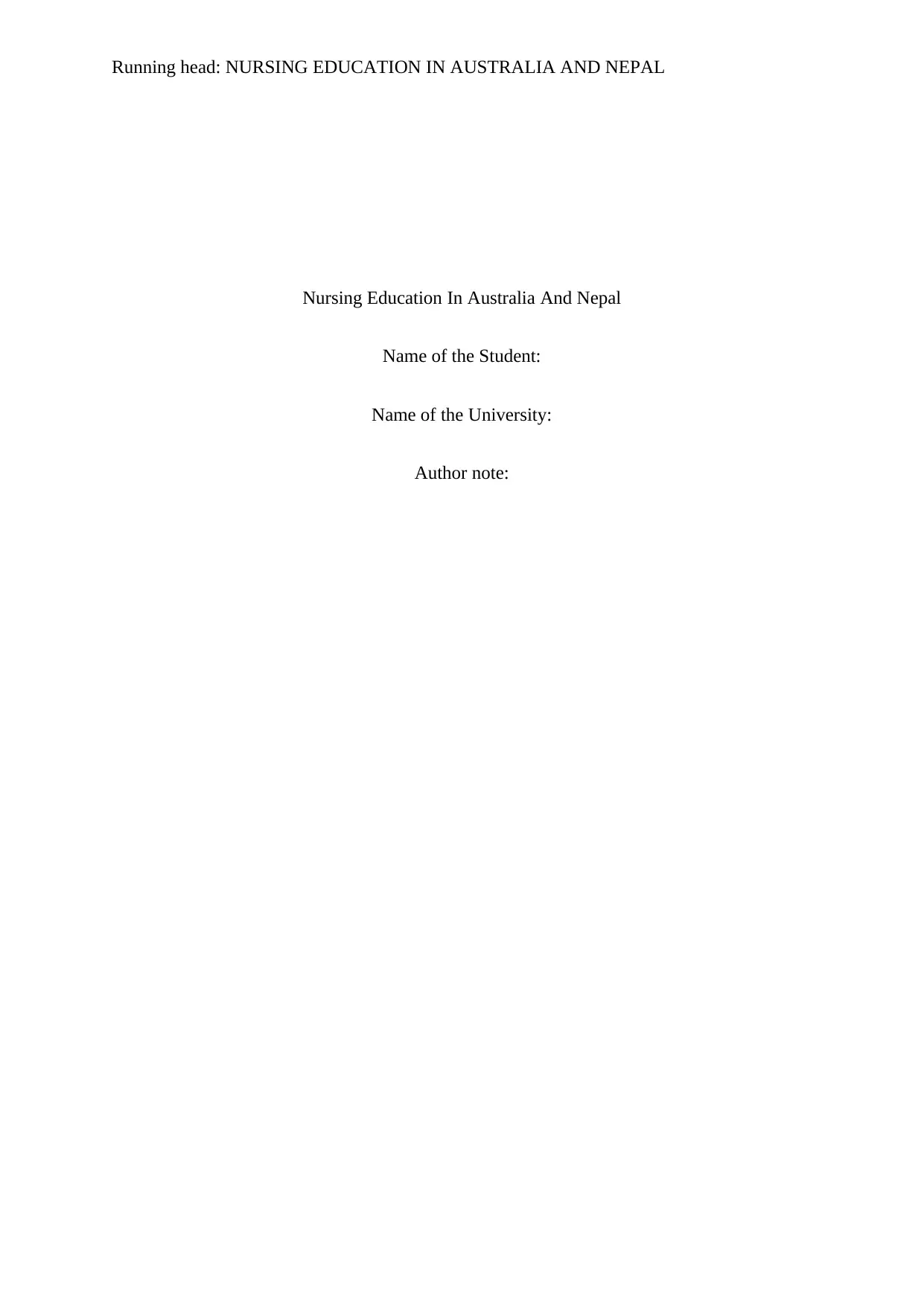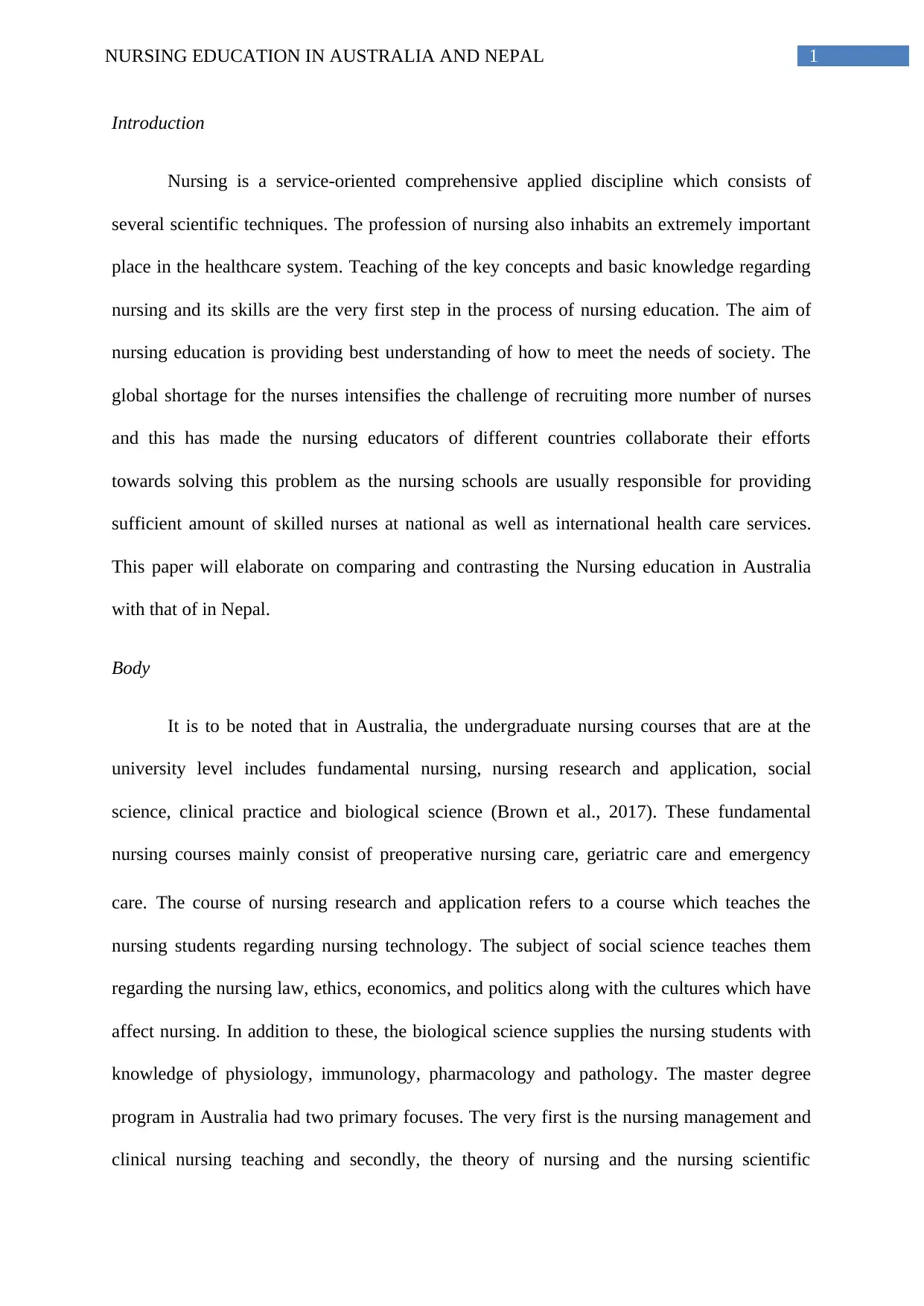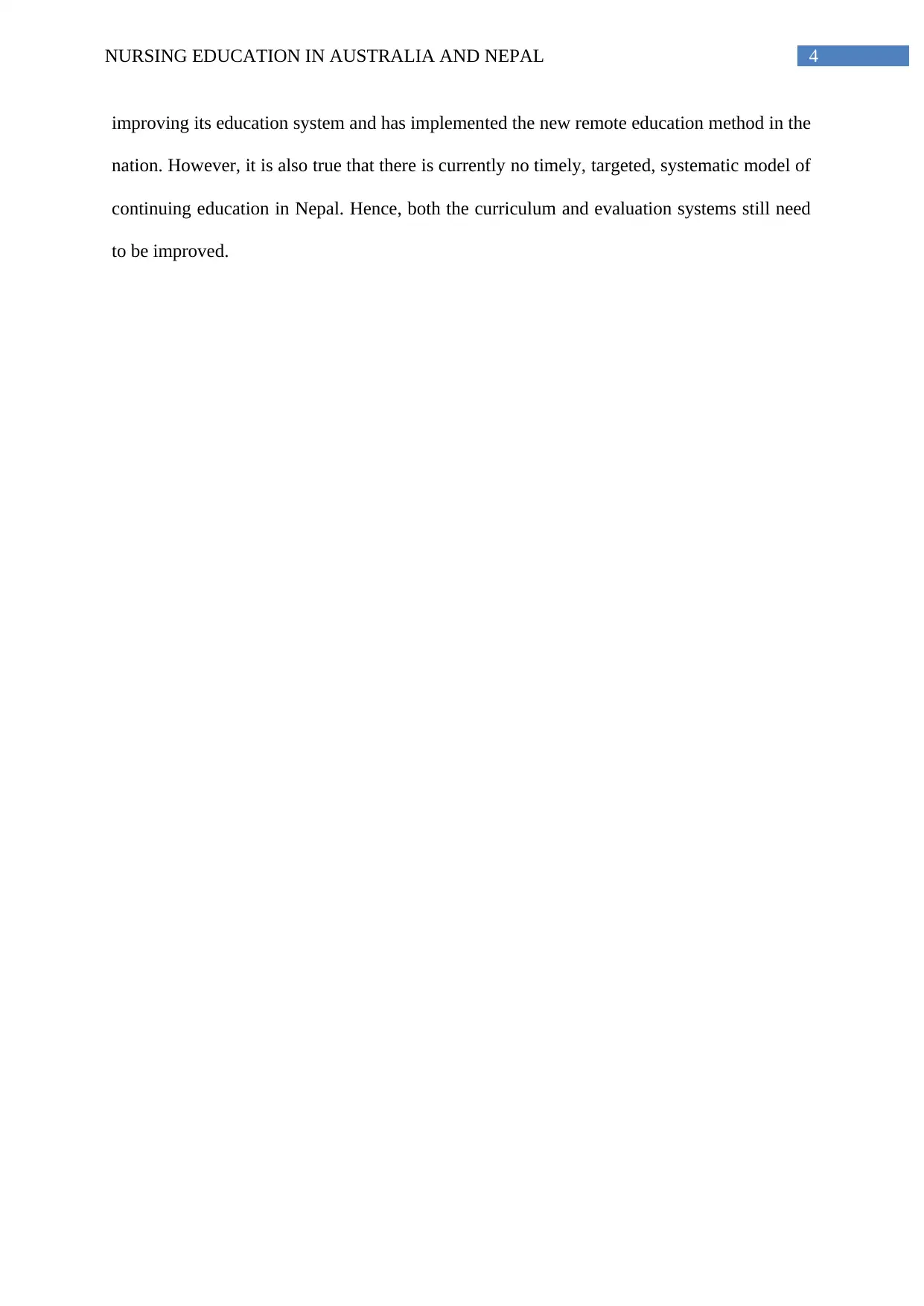A Comparative Analysis of Nursing Education in Australia and Nepal
VerifiedAdded on 2021/06/17
|6
|1265
|31
Essay
AI Summary
This essay provides a comparative analysis of nursing education in Australia and Nepal. It begins by introducing the importance of nursing education in addressing global healthcare needs. The body of the essay delves into the specifics of undergraduate and postgraduate nursing programs in both countries, including curriculum content (fundamental nursing, nursing research, social science, and biological science in Australia; basic medical courses and clinical practice in Nepal), teaching methods (collaborative and theory-linked in Australia versus traditional lecture-based in Nepal), and evaluation systems (comprehensive and technologically-supported in Australia versus theory-focused in Nepal). The essay highlights the emphasis on multicultural development and practical application in Australia, contrasting it with Nepal's focus on clinical nursing and the challenges of integrating theory and practice. It also examines the 'continuing nursing education' programs in both countries. The conclusion summarizes the key differences, noting Australia's more advanced system and Nepal's ongoing efforts to improve its nursing education, particularly in terms of curriculum, evaluation, and continuing education models. The essay references several scholarly articles to support its arguments.

Running head: NURSING EDUCATION IN AUSTRALIA AND NEPAL
Nursing Education In Australia And Nepal
Name of the Student:
Name of the University:
Author note:
Nursing Education In Australia And Nepal
Name of the Student:
Name of the University:
Author note:
Paraphrase This Document
Need a fresh take? Get an instant paraphrase of this document with our AI Paraphraser

1NURSING EDUCATION IN AUSTRALIA AND NEPAL
Introduction
Nursing is a service-oriented comprehensive applied discipline which consists of
several scientific techniques. The profession of nursing also inhabits an extremely important
place in the healthcare system. Teaching of the key concepts and basic knowledge regarding
nursing and its skills are the very first step in the process of nursing education. The aim of
nursing education is providing best understanding of how to meet the needs of society. The
global shortage for the nurses intensifies the challenge of recruiting more number of nurses
and this has made the nursing educators of different countries collaborate their efforts
towards solving this problem as the nursing schools are usually responsible for providing
sufficient amount of skilled nurses at national as well as international health care services.
This paper will elaborate on comparing and contrasting the Nursing education in Australia
with that of in Nepal.
Body
It is to be noted that in Australia, the undergraduate nursing courses that are at the
university level includes fundamental nursing, nursing research and application, social
science, clinical practice and biological science (Brown et al., 2017). These fundamental
nursing courses mainly consist of preoperative nursing care, geriatric care and emergency
care. The course of nursing research and application refers to a course which teaches the
nursing students regarding nursing technology. The subject of social science teaches them
regarding the nursing law, ethics, economics, and politics along with the cultures which have
affect nursing. In addition to these, the biological science supplies the nursing students with
knowledge of physiology, immunology, pharmacology and pathology. The master degree
program in Australia had two primary focuses. The very first is the nursing management and
clinical nursing teaching and secondly, the theory of nursing and the nursing scientific
Introduction
Nursing is a service-oriented comprehensive applied discipline which consists of
several scientific techniques. The profession of nursing also inhabits an extremely important
place in the healthcare system. Teaching of the key concepts and basic knowledge regarding
nursing and its skills are the very first step in the process of nursing education. The aim of
nursing education is providing best understanding of how to meet the needs of society. The
global shortage for the nurses intensifies the challenge of recruiting more number of nurses
and this has made the nursing educators of different countries collaborate their efforts
towards solving this problem as the nursing schools are usually responsible for providing
sufficient amount of skilled nurses at national as well as international health care services.
This paper will elaborate on comparing and contrasting the Nursing education in Australia
with that of in Nepal.
Body
It is to be noted that in Australia, the undergraduate nursing courses that are at the
university level includes fundamental nursing, nursing research and application, social
science, clinical practice and biological science (Brown et al., 2017). These fundamental
nursing courses mainly consist of preoperative nursing care, geriatric care and emergency
care. The course of nursing research and application refers to a course which teaches the
nursing students regarding nursing technology. The subject of social science teaches them
regarding the nursing law, ethics, economics, and politics along with the cultures which have
affect nursing. In addition to these, the biological science supplies the nursing students with
knowledge of physiology, immunology, pharmacology and pathology. The master degree
program in Australia had two primary focuses. The very first is the nursing management and
clinical nursing teaching and secondly, the theory of nursing and the nursing scientific

2NURSING EDUCATION IN AUSTRALIA AND NEPAL
research. On the other hand, in Nepal, the curriculum that is being followed in most of the
nursing colleges there is yet the traditional “Discipline-Centered” model, that mainly
comprised of basic medical course and nursing, public elementary courses, and the clinical
practices (Nepal et al., 2016). The Nepalese curriculum highlights the ‘discipline theory
knowledge systems’ and integrity. Nevertheless, the perplexing relation in between the theory
and practice is significant.
Furthermore, Australia always puts more focus on the multicultural development of
the learners by providing them more knowledge about the community nursing and the
humanities. The teaching content in this region displays the “Biological-Psychological-Social
Medical” model (Deng, 2015). There is a close relations in between the theoretical learning
and practice, alternately, spotlighting the main characteristics of nursing along with practical
and cultural knowledge.On the other hand, in Nepal, the courses of nursing in the country pay
more attention on clinical nursing. It focuses on classification of clinical diseases that
comprise of labor education. With the same, the course also emphasizes on the professional
and political knowledge. In order to transmit knowledge, educators in Nepal have long led the
teaching process, with learners rarely actively learning. The Clinical practice is then arranged
right after completing all the theoretical learning (approx. 1 year).
It is also to be noted that in Australia, the teaching methods are collaborated with the
theoretical studies and this is further inspiration thinking and ability cultivation among the
learners. In contrast to this, as it is discussed above, the traditional teaching method of the
lectures is still in use. The Students here listen to what their teachers convey and also there is
a very strict importance given to standardization of operational steps and procedures. The
clinical practices are arranged in final year; hence, this makes it very easy to keep practice
teaching and theory teaching disconnected.
research. On the other hand, in Nepal, the curriculum that is being followed in most of the
nursing colleges there is yet the traditional “Discipline-Centered” model, that mainly
comprised of basic medical course and nursing, public elementary courses, and the clinical
practices (Nepal et al., 2016). The Nepalese curriculum highlights the ‘discipline theory
knowledge systems’ and integrity. Nevertheless, the perplexing relation in between the theory
and practice is significant.
Furthermore, Australia always puts more focus on the multicultural development of
the learners by providing them more knowledge about the community nursing and the
humanities. The teaching content in this region displays the “Biological-Psychological-Social
Medical” model (Deng, 2015). There is a close relations in between the theoretical learning
and practice, alternately, spotlighting the main characteristics of nursing along with practical
and cultural knowledge.On the other hand, in Nepal, the courses of nursing in the country pay
more attention on clinical nursing. It focuses on classification of clinical diseases that
comprise of labor education. With the same, the course also emphasizes on the professional
and political knowledge. In order to transmit knowledge, educators in Nepal have long led the
teaching process, with learners rarely actively learning. The Clinical practice is then arranged
right after completing all the theoretical learning (approx. 1 year).
It is also to be noted that in Australia, the teaching methods are collaborated with the
theoretical studies and this is further inspiration thinking and ability cultivation among the
learners. In contrast to this, as it is discussed above, the traditional teaching method of the
lectures is still in use. The Students here listen to what their teachers convey and also there is
a very strict importance given to standardization of operational steps and procedures. The
clinical practices are arranged in final year; hence, this makes it very easy to keep practice
teaching and theory teaching disconnected.
⊘ This is a preview!⊘
Do you want full access?
Subscribe today to unlock all pages.

Trusted by 1+ million students worldwide

3NURSING EDUCATION IN AUSTRALIA AND NEPAL
In Australia, the methods of evaluation consist of many procedures, inclusive of the
oral and written book reports, clinical ability tests, case discussions etc (Clark, 2016). The
State government department of education along with the Association of State Boards of
Nursing collaboratively reviews the nursing educational standards. With the same, the
Computer network information management prevailing in Australia is a key guarantee of the
quality control. Conversely, in Nepal, the education evaluation specifically emphasizes on
theory, hence, the written tests are the main teaching evaluation method prevailing there.
However, it is also to be mentioned that the student evaluation system has changed to a great
extent in Nepal in the recent years. It also has attached utmost importance to the clinical,
theoretical, along with the comprehensive evaluations. However, still the system requires
many improvements. It fails to comprehensively test the problem solving abilities and the
independent analysis. Also, another problem here is that the nursing education of Nepal is not
independent, and it indeed lacks in special features as compared to the entire nursing field.
This results in limiting the nursing knowledge and professional development of nursing
education.
Lastly, in Australia, ‘continuing nursing education’ merges the nursing degree
education with the job training. This provides enough learning platforms and opportunities
for the nurses. Also, there are many nursing upgrade courses, short-term training courses,
remote nursing education courses and post-graduate education in Australia. However, in
recent years, Nepal too has paid much attention to the ‘continuing nursing education’ and it
needs to get improved a lot in order to compete with Australia.
Conclusion
To sum up, it can be said that as compared to Nepal, Australia has far more better
nursing education system inn country. Although at present, Nepal too is focusing on
In Australia, the methods of evaluation consist of many procedures, inclusive of the
oral and written book reports, clinical ability tests, case discussions etc (Clark, 2016). The
State government department of education along with the Association of State Boards of
Nursing collaboratively reviews the nursing educational standards. With the same, the
Computer network information management prevailing in Australia is a key guarantee of the
quality control. Conversely, in Nepal, the education evaluation specifically emphasizes on
theory, hence, the written tests are the main teaching evaluation method prevailing there.
However, it is also to be mentioned that the student evaluation system has changed to a great
extent in Nepal in the recent years. It also has attached utmost importance to the clinical,
theoretical, along with the comprehensive evaluations. However, still the system requires
many improvements. It fails to comprehensively test the problem solving abilities and the
independent analysis. Also, another problem here is that the nursing education of Nepal is not
independent, and it indeed lacks in special features as compared to the entire nursing field.
This results in limiting the nursing knowledge and professional development of nursing
education.
Lastly, in Australia, ‘continuing nursing education’ merges the nursing degree
education with the job training. This provides enough learning platforms and opportunities
for the nurses. Also, there are many nursing upgrade courses, short-term training courses,
remote nursing education courses and post-graduate education in Australia. However, in
recent years, Nepal too has paid much attention to the ‘continuing nursing education’ and it
needs to get improved a lot in order to compete with Australia.
Conclusion
To sum up, it can be said that as compared to Nepal, Australia has far more better
nursing education system inn country. Although at present, Nepal too is focusing on
Paraphrase This Document
Need a fresh take? Get an instant paraphrase of this document with our AI Paraphraser

4NURSING EDUCATION IN AUSTRALIA AND NEPAL
improving its education system and has implemented the new remote education method in the
nation. However, it is also true that there is currently no timely, targeted, systematic model of
continuing education in Nepal. Hence, both the curriculum and evaluation systems still need
to be improved.
improving its education system and has implemented the new remote education method in the
nation. However, it is also true that there is currently no timely, targeted, systematic model of
continuing education in Nepal. Hence, both the curriculum and evaluation systems still need
to be improved.

5NURSING EDUCATION IN AUSTRALIA AND NEPAL
References:
Brown, D., Edwards, H., Seaton, L., & Buckley, T. (2017). Lewis's Medical-Surgical
Nursing: Assessment and Management of Clinical Problems. Elsevier Health
Sciences.
Clark, S. (2016). An exploratory study examining the influence of the number of reading
methods courses on pre-service and in-service teacher perceptions of ability to teach
reading. Asia-Pacific Journal of Teacher Education, 44(2), 125-141.
Deng, F. F. (2015). Nursing education in Australia. Australian Nursing Research, 2(4), 96-98.
Nepal, B., Taketomi, K., Ito, Y., Kohanawa, M., Kawabata, H., Tanaka, M., & Otaki, J.
(2016). Nepalese undergraduate nursing students' perceptions of the clinical learning
environment, supervision and nurse teachers: A questionnaire survey. Nurse
Education Today, 39, 181-188.
References:
Brown, D., Edwards, H., Seaton, L., & Buckley, T. (2017). Lewis's Medical-Surgical
Nursing: Assessment and Management of Clinical Problems. Elsevier Health
Sciences.
Clark, S. (2016). An exploratory study examining the influence of the number of reading
methods courses on pre-service and in-service teacher perceptions of ability to teach
reading. Asia-Pacific Journal of Teacher Education, 44(2), 125-141.
Deng, F. F. (2015). Nursing education in Australia. Australian Nursing Research, 2(4), 96-98.
Nepal, B., Taketomi, K., Ito, Y., Kohanawa, M., Kawabata, H., Tanaka, M., & Otaki, J.
(2016). Nepalese undergraduate nursing students' perceptions of the clinical learning
environment, supervision and nurse teachers: A questionnaire survey. Nurse
Education Today, 39, 181-188.
⊘ This is a preview!⊘
Do you want full access?
Subscribe today to unlock all pages.

Trusted by 1+ million students worldwide
1 out of 6
Related Documents
Your All-in-One AI-Powered Toolkit for Academic Success.
+13062052269
info@desklib.com
Available 24*7 on WhatsApp / Email
![[object Object]](/_next/static/media/star-bottom.7253800d.svg)
Unlock your academic potential
Copyright © 2020–2025 A2Z Services. All Rights Reserved. Developed and managed by ZUCOL.





